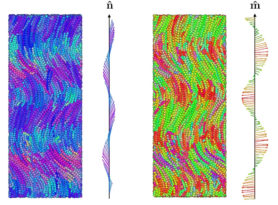
Massimiliano Chiappini
Leonard S. Ornstein Laboratory, room 0.14
Princetonplein 1, 3584 CC Utrecht
P.O. Box 80 000, 3508 TA Utrecht
The Netherlands
phone: +31 (0)30 253 2831
secretariat: +31 (0)30 253 2952
e-mail: m.chiappini@uu.nl
Research
Promotor: Prof. dr. ir. Marjolein Dijkstra
Funding: Marie Curie Actions ERC
Employed: 1 Oct 2016 – 30 Sept 2020
Of Twist, Bend and Other Deformations
In a seminal work of 1958, F. C. Frank introduced a continuum theory of mechanical deformations in nematic liquid crystals [1], paving the way for the physics of spontaneously deformed nematic phases.
Working on Frank’s theory, R. B. Meyer [2] and I. Dozov [3] noticed that a nematic state with a deformation of pure bend could not exist, whereas in order to homogeneously fill the space and eventually become thermodynamically stable the bend deformation has to be accompanied by either a twist or a splay deformation, postulating the existence of the so-called twist-bend and splay-bend nematic phases. Since then, many stable twist-bend nematic states have been identified and extensively characterized both in experiments and simulations. Vice versa, a stable splay-bend nematic state has not yet ever been found in experiments or simulations, the splay-bend nematic phase remaining elusive after almost 20 years.
In my research I perform computational studies of the phase behaviour of hard particles of various shape and size in order to identify the ingredients necessary for the twist- and/or splay-bend nematic phases to be stabilized. In particular, I have recently been exploring the hypothesis of particles’ curvature to be the main responsible for the formation of spontaneously deformed nematics of bent-core mesogens. From this hypothesis, a mechanism of propagation of curvature from the microscopic to the macroscopic scale can be theorized leading to interesting consequences, as the stability of the splay-bend nematic phase and the reverse engineering of the pitch of the twist-bend nematic phase. In the future I will test this hypothesis by means of an extensive computational study, in order to locate a stable splay-bend nematic phase and characterize both the twist- and the splay-bend nematic phases of bent-core mesogens.
Figure 1: A twist-bend nematic state.
[1] F.C. Frank, Discuss. Farad. Soc., 25 (1958)
[2] R.B. Meyer, in Molecular Fluids, Gordon and Breach, New York (1976), pp. 271-343
[3] I. Dozov, Europhysics Letters, 56 (2001)

